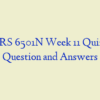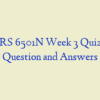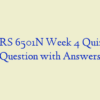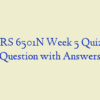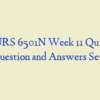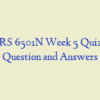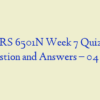Description
NURS 6501N Midterm Exam (100 out of 100)
- A professor has taught the students about the pathogenesis of abdominal pain. Which statement by a student indicates the professor needs to review the material?
- Which cardiac chambers have the thinnest wall and why?
- A healthcare provider notes that tapping the patient’s facial nerve leads to lip twitching. What electrolyte value is correlated with this finding?
- What is the cause of functional dysphagia?
- Which gastric hormone inhibits acid and pepsinogen secretion, as well as decreases the release of gastrin?
- What is one function of the tumor cell marker?
- Why is the leakage of lysosomal enzymes during chemical injuries significant?
- The student wants information about a patient’s renal function. What test does the healthcare professional tell the student to evaluate?
- A student is preparing to irrigate a patient’s wound and gathers supplies, including hydrogen peroxide. What response by the health care professional is best?
- A patient suffered multiple traumatic injuries and received many blood transfusions within a few days of the injuries. For which medical condition should the healthcare professional monitor the patient for?
- The data reporting that sickle cell disease affects approximately 1 in 600 American blacks is an example of which concept?
- A patient has a history of excessive use of magnesium-containing antacids and aluminum-containing antacids. What lab value does the healthcare professional correlate to this behavior?
- A student asks why some vaccinations are given orally and some are given by injection. What response by the professor is best?
- A person wants to know if eating only plant-based foods is advisable as a way to cut cholesterol to near-zero levels. What response by the health care professional is best?
- What is the initiating event that leads to the development of atherosclerosis?
- The cardiac electrical impulse normally begins spontaneously in the sinoatrial (SA) node because of what reason?
- An amniocentesis indicates a neural tube defect when an increase in which protein is evident?
- When comparing the clinical manifestations of both diabetic ketoacidosis (DKA) and hyperglycemic hyperosmolar nonketotic syndrome (HHNKS), which condition is associated with only DKA?
- A student learns what information about acute pancreatitis?
- If a patient develops acidosis, the nurse would expect the oxyhemoglobin dissociation curve to react in which manner?
- A student asks the professor to differentiate Type 2 diabetes mellitus from Type 1. The professors’ response would be that Type 2 is best described as what?
- The healthcare professional explains to a student that the amount of volume of blood in the heart is directly related to the _____ of contraction.
- What is apoptosis?
- In regulating vascular mediators released from mast cells, the role of eosinophils is to release what?
- A professor has taught a student about skeletal alterations seen in chronic kidney disease. Which statement by the student indicates the professor needs to give more information?
- The action of platelet-derived growth factor is to stimulate the production of which cells?
- A patient is in severe shock and is receiving vasopressin. A student asks the health care professional to explain the rationale for this treatment. What response by the professional is most accurate?
- What effect is a result of inhibiting the parasympathetic nervous system with a drug such as atropine?
- People diagnosed with neurofibromatosis have varying degrees of the condition because of which genetic principle?
- Which term is used to identify the movement of gas and air into and out of the lungs?
- A healthcare professional wants to determine the adequacy of a person’s alveolar ventilation. What assessment finding is most important for the professional to consider?
- Renal failure is the most common cause of which type of hyperparathyroidism?
- What is the cause of familial hypercholesterolemia (FH)?
- What is the single most common cause of cellular injury?
- A student asks the professor how a faulty negative-feedback mechanism results in a hormonal imbalance. What response by the professor is best?
- Oxygenated blood flows through which vessel?
- A patient in the hospital has hypernatremia. What condition should the healthcare professional assess for?
- A healthcare professional is caring for four patients. Which patient should the professional assess for hyperkalemia?
- The acute inflammatory response is characterized by a fever that is produced by the hypothalamus being affected by what?
- A student asks the healthcare professional to explain the pathophysiologic process of alcoholic cirrhosis. What statement by the professional would not be consistent with complete knowledge about this process?
- A healthcare professional tells a student that a patient has lost atrial kick. What would the student expect to see when examining this patient?
- During cell injury caused by hypoxia, why does an increase in the osmotic pressure within the cell occur?
- The Bainbridge reflex is thought to be initiated by sensory neurons in which cardiac location?
- Which primary characteristic is unique for the immune response?
- A patient has been admitted for a possible small intestinal obstruction. What is the first sign the healthcare professional assesses for that would indicate the presence of this condition?
- Which type of immunity is produced by an individual after either natural exposure to the antigen or after immunization against the antigen?
- What is the major determinant of the resistance that blood encounters as it flows through the systemic circulation?
- Free radicals play a major role in the initiation and progression of which diseases?
- A patient asks the healthcare professional why tissue damage occurs in acute rejection after organ transplantation. What response by the professional is best?
- Under anaerobic conditions, what process provides energy for the cell?
- A patient reports dumping syndrome after partial gastrectomy. What does healthcare professional teach this patient?
- Which statement made by a student indicates the healthcare professional needs to describe the pericardium again?
- The student asks the professor to explain what characteristic is demonstrated by the lungs with decreased compliance?
- A student studying biology asks the professor to describe how the ras gene is involved in cancer proliferation. What explanation by the professor is best?
- How do free radicals cause cell damage?
- A patient had a myocardial infarction that damaged the SA node, which is no longer functioning as the pacemaker of the heart. What heart rate would the healthcare provider expect the patient to have?
- A patient is having a spirometry measurement done and asks the healthcare professional to explain this test. What response by the professional is best?
- How does progressive nephron injury affect angiotensin II activity?
- What are blood pressure variations associated with?
- During acidosis, the body compensates for the increase in serum hydrogen ions by shifting hydrogen ions into the cell in exchange for which electrolyte?
- A person has hypothyroidism. What chemical does the healthcare professional advise the person to include in the diet?
- What is the blood type of a person who is heterozygous, having A and B alleles as codominant?
- A class of students has learned about contributing factors to duodenal ulcers. What statement indicates to the professor that the students need a review?
- A healthcare professional is conducting community education on vaccinations. Which statement about vaccines does the professional include in the presentation?
- Which hormone is required for water to be reabsorbed in the distal tubule and collecting duct?
- During the cardiac cycle, why do the aortic and pulmonic valves close after the ventricles relax?
- A healthcare professional is caring for a patient undergoing chemotherapy. What is the skin-related health risk the professional should assess the patient for and be prepared to treat?
- A patient has portal hypertension-induced splenomegaly. Which lab value would the healthcare professional associate with this condition?
- A healthcare professional is caring for four patients. Which patient does the professional assess for pulmonary emboli (PE) as the priority?
- A healthcare professional is working with a person who drinks several 6-packs of beer a week. What testing does the professional encourage the person to get?
- What physical sign does the healthcare professional relate to the result of turbulent blood flow through a vessel?
- What is the only surface inside the nephron where cells are covered with microvilli to increase the reabsorptive surface area called?
- A patient has been diagnosed with a renal stone. Based on the knowledge of common stone types, what self-care measure does the healthcare professional plan to teach the patient when stone analysis has returned?
- A patient asks the healthcare professional to describe the cause of gastroesophageal reflux disease (GERD). What response by the professional is best?
- A student asks the healthcare professional to explain the function of the papillary muscles. What response by the professional is best?
- A patient has diabetes mellitus. A recent urinalysis showed increased amounts of protein. What therapy does the healthcare provider educate the patient that is specific to this disorder?
- It has been determined that a patient’s tumor is in stage 2. How does the healthcare professional describe this finding to the patient?
- A healthcare professional is assessing a child who has complete trisomy of the twenty-first chromosome. What findings does the professional relationship to this condition?
- What is the second most commonly recognized genetic cause of intellectual disability?
- Pressure in the left ventricle must exceed the pressure in which structure before the left ventricle can eject blood?
- A pregnant woman has Graves disease. What test/s does the healthcare professional advise the woman about?
- Which chamber of the heart endures the highest pressures?
- Once they have penetrated the first line of defense, which microorganisms do natural killer (NK) cells actively attack?
- In teaching a women’s community group, which risk factor does the healthcare professional teach is related to high morbidity of cancer of the colon, uterus, and kidney?
- A healthcare professional is caring for four patients. Which patient does the professional assess for neurogenic diabetes insipidus (DI)?
- Which patient would the healthcare professional assess for other signs of thyrotoxic crisis?
- Within a physiologic range, what does an increase in left ventricular end-diastolic volume (preload) result in?
- What is the inflammatory effect of nitric oxide (NO)?
- What is the role of reverse transcriptase in HIV infection?
- A student asks why carbon monoxide causes tissue damage. What response by the professor is best?
- A healthcare professional care for older adults in a skilled nursing facility. What should the professional assess for in these individuals related to cardiovascular functioning?
- What are tumor cell markers?
- A female patient has been diagnosed with an uncomplicated urinary tract infection. What self-care measure does the healthcare provider teach the patient that is specific to this type of infection?
- What pathologic change occurs to the kidney’s glomeruli as a result of hypertension?
- Surfactant produced by type II alveolar cells facilitates alveolar distention and ventilation by which mechanism?
- What is the process that ensures mitral and tricuspid valve closure after the ventricles are filled with blood?
- A healthcare professional is educating a patient about asthma. The professional states that good control is necessary due to which pathophysiologic process?
- A patient had a thyroidectomy and now reports tingling around the mouth and has a positive Chvostek sign. What laboratory finding would be most helpful to the healthcare professional?
- A patient’s urinalysis came back positive for glucose. What does the healthcare professional expect the patient’s blood glucose to be at a minimum?
- The student asks the professor why water and electrolytes are transported in both directions through tight junctions and intercellular spaces rather than across cell membranes. What response by the professor is best?




